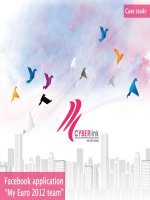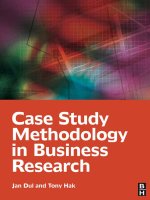Case study ESSS milestone 01 scope definition
Bạn đang xem bản rút gọn của tài liệu. Xem và tải ngay bản đầy đủ của tài liệu tại đây (156.67 KB, 10 trang )
SADM 7/ed - ESSS CASE STUDY - Milestone 1: Scope Definition
Page: 1-1
ESSS
MILESTONE 1 – SCOPE DEFINITION
T
Synopsis
he purpose of the preliminary investigation phase is threefold. First, it answers the
question, “Is this project worth looking at?” To answer this question, this phase must
define the scope of the project and the perceived problems, opportunities, and directives
that triggered it.
In this milestone you will prepare a Request for System Services, which is the trigger for the
Preliminary Investigation Phase. Also, you will use fact-finding techniques to extract and
analyze information from an interview to determine project scope, level of management
commitment, and project feasibility for the Employee Self Service System (ESSS). With these
facts and facts obtained from the Case Background, you will have the necessary information to
complete the Problem Statement Matrix and construct the Project Feasibility Assessment Report.
Objectives
After completing this milestone, you should be able to
⇒ Complete a Request for System Services form, which triggers the preliminary investigation
phase.
⇒ Analyze a user interview and extract pertinent facts, which can be used to assess project
feasibility.
⇒ Complete a Problem Statement Matrix documenting the problems, opportunities, or
directives of the project.
⇒ Prepare and understand the structure and content, of the Project Feasibility Assessment
Report.
Prerequisites
Before starting this milestone the following topics should be covered:
Prepared by Gary B. Randolph for
Systems Analysis & Design Methods 7ed
by J. L. Whitten, L. D. Bentley, & K. C. Dittman
Copyright Irwin/McGraw-Hill 2007
SADM 7/ed - ESSS CASE STUDY - Milestone 1: Scope Definition
Page: 1-2
1. The preliminary investigation phase — Chapters 3 and 5.
2. Optional: project management — Chapter 4.
Assignment
We have been contacted by Mr. Jack Mills, the vice president of Human Resources for A-1
Information Systems, to analyze how A-1 IS manages its employee information and to design
an appropriate system. In this assignment you first need to assist Jack Mill’s subject matter
expert Dottie Jones in preparing a Request for Systems Services. Secondly, by analyzing the
interview transcripts, you must determine the feasibility of the project, level of management
commitment, and project scope by using fact-finding techniques and the necessary
communication skills to compose the Problem Statement Matrix and, as an advanced option, the
Project Feasibility Assessment Report.
Mr. Mills was gracious enough to allow us to record our interview session and Exhibit 1.1 is a
copy of the transcripts. Refer to the Case Background found in the Introduction and the
interview transcripts for the information necessary to complete the following activities.
Activities
1. To complete the Request for System Services form, use primarily the information from the
case background. Make assumptions where necessary.
2. To complete the Problem Statement Matrix, use the interview with Jack Mills and the case
background as your information. Make assumptions where necessary. Place yourself in the
shoes of Jack Mills. Which problems do you believe have the highest visibility, and how
should they be ranked? Try to determine the annual benefits. State assumptions and be
prepared to justify your answers! Finally, what would be your proposed solution based on
the facts you know now?
Your instructor will specify deliverable format and software to be used. Deliverables should be
neatly packaged in a binder, separated with a tab divider labeled “Milestone 1,” and
accompanied with a Milestone Evaluation Sheet.
References and Templates:
Case Background
Workbook Introduction
Transcripts of Interview with Jack Mills
Exhibit 1.1
Templates
See the online learning center website for the textbook.
Prepared by Gary B. Randolph for
Systems Analysis & Design Methods 7ed
by J. L. Whitten, L. D. Bentley, & K. C. Dittman
Copyright Irwin/McGraw-Hill 2007
SADM 7/ed - ESSS CASE STUDY - Milestone 1: Scope Definition
Page: 1-3
Deliverables:
Request for System Services:
Due: __/__/__
Time:_______
Problem Statement Matrix:
Due: __/__/__
Time:_______
ADVANCED OPTION
For the advanced option, prepare a Project Feasibility Assessment Report. Use the
information provided by the case background, the user interview, and the completed
problem statement matrix. Be sure to include a Statement of Work and Gantt charts
for the project schedules. Information on the Statement of Work and Gantt charts can
be found in Chapter 4 of the SADM 7th ed. textbook.
Project Feasibility Assessment Report:
Milestone’s Point Value:
Prepared by Gary B. Randolph for
Systems Analysis & Design Methods 7ed
by J. L. Whitten, L. D. Bentley, & K. C. Dittman
Due: __/__/__
Time:_______
_______
Copyright Irwin/McGraw-Hill 2007
SADM 7/ed - ESSS CASE STUDY - Milestone 1: Scope Definition
Page: 1-4
The following is a copy of the transcripts of an interview between Mr. Jack Mills of A-1
Information Systems and Kira Webster, who has just started with A-1 IS as a systems analyst.
This was the initial interview with Mr. Mills and its goal was to obtain facts about the problems
and opportunities that triggered the project request, plus other general information that could be
used to prepare the Problem Statement Matrix.
Exhibit 1.1
Scene: Kira Webster is meeting with Jack Mills, Vice President of Human Resources for A-1
Information Systems, at his office. Ms. Webster scheduled the interview with Mr. Mills in
response to his request for developing a new system to house employee information.
Jack:
Good Morning! You must be Kira Webster.
Kira:
Yes, I am sir. Are you Mr. Jack Mills?
Jack:
Yes. Please call me Jack. I’m glad we could get together today. Things are quite chaotic
around here.
Kira:
What do you mean?
Jack:
Our executive steering committee is very anxious to set in motion our plan for
reengineering and modernizing our systems and computing resources. The first phase of
that plan concentrates on Human Resources, and that is why you are here.
Kira:
That’s sounds like an enormous task, but I love challenges.
Jack:
It is monumental, but we tried to simplify the task by breaking it up into smaller pieces.
The first piece deals with the tracking and management of employee information.
Kira:
What is your current system like?
Jack:
My Employee Relations manager, Dotty Jones, who by the way will be your key user
contact, explained the process in detail to me yesterday. I don’t interact with it myself,
but it appears there are a lot of inefficiencies and its operating costs are exorbitant. The
system itself is a combination of manual and automated processes. The automated
processes reside in both microcomputers and legacy mainframe systems.
Kira:
Will this system replace all the legacy systems?
Jack:
Not all of them initially. That is too big and risky of an effort unless we were going to
install an SAP or Peoplesoft product and we can’t currently afford that. Right now we
are concentrating on reengineering the current employee information system to meet our
needs. If that means new interfaces have to be built for the legacy payroll and time and
attendance systems, for the time being that’s fine.
Kira:
Could you please describe for me the business processes that will be included in the
system?
Prepared by Gary B. Randolph for
Systems Analysis & Design Methods 7ed
by J. L. Whitten, L. D. Bentley, & K. C. Dittman
Copyright Irwin/McGraw-Hill 2007
SADM 7/ed - ESSS CASE STUDY - Milestone 1: Scope Definition
Page: 1-5
Jack:
I think the best way to explain the process is to start from the beginning. The first day
employees report to work they go through an orientation program. During that program
they are required to complete some personnel forms that include information such as
addresses, phone numbers, emergency contact information, and beneficiary information.
They can also elect to have various things deducted from their paychecks, including
United Way donations, parking, extra life insurance, and the pre-tax medical
reimbursement plan. This data is then input into the legacy mainframe system by one of
my administrators. This is a COBOL-based system using, in my opinion, obsolete
database and file technology. I say that because every time another system needs
employee data, we have to send them a sequential file sometimes daily, weekly, or
monthly. So we have multiple copies of employee information throughout our systems,
which may or may not be in sync.
Kira:
What do you mean by that?
Jack:
If employees need to change any of their personal information that we have on file, they
must complete a form and submit it to us to be input into the system. Currently, it could
be weeks before that change gets distributed across all the necessary systems. This is
especially critical for payroll. People aren’t very happy if they don’t receive their checks
on time because they have moved and the payroll system doesn’t have their current
address.
Kira:
I can understand that concern. You mentioned a micro application. Where does that come
into play?
Jack:
Oh. On a quarterly basis we produce and publish an employee telephone listing, sort of a
company telephone book, which consists of the employee’s work telephone number and
work location. This information resides on a microcomputer that is maintained by Alice
Cockran, an administrator, who works for Dotty. Because we are such a dynamic and
growing company, Alice spends 30 percent of her workweek maintaining the information.
Each quarter we produce 5,000 copies of the book and distribute them across the
company. Currently this process costs the company $27,000 a year. The sad thing is, the
book is probably already out of date the day it is published.
Kira:
What do you mean?
Jack:
We are a large and growing company with sites all over the nation. Every day at least
someone is hired or transferred, moves offices, or is terminated. These events all trigger a
change to the listing.
Kira:
It sounds like a losing battle.
Jack:
We do our best. Besides you are going to help us win it, right?
Kira:
I’m going to do my best! Why doesn’t the mainframe system produce the telephone book
instead of the micro system?
Jack:
Good question. The mainframe system doesn’t have all the necessary employee
information to produce the listing and I am told that to add that capability to the
mainframe system would be quite an undertaking and costly.
Kira:
Why?
Prepared by Gary B. Randolph for
Systems Analysis & Design Methods 7ed
by J. L. Whitten, L. D. Bentley, & K. C. Dittman
Copyright Irwin/McGraw-Hill 2007
SADM 7/ed - ESSS CASE STUDY - Milestone 1: Scope Definition
Page: 1-6
Jack:
Because it would require changing the current file structures, which then requires
changing all the programs, and so on. What a nightmare! I know every time I ask to do
an ad-hoc report my IS rep cringes at the thought and gives me some excuse. You would
think that a system that costs over $300,000 a year just to maintain and operate could
produce reports when I needed them. But the system’s current technology doesn’t support
that type of functionality. That’s why we need a new system!
Kira:
Is there at least an automated interface between the mainframe system and the micro
system?
Jack:
I wish there were! Currently we have to input the data twice, once into the mainframe
and then into the micro application.
Kira:
Let’s switch gears and talk about the people that use the systems. You mentioned that
Alice is responsible for the telephone listing system. Who are the other people involved?
Jack:
If you really think about it, everyone is affected or uses the system in some way, whether
directly or indirectly. Currently only Human Resources employees can directly use the
systems. But I would like to see that changed. There is no reason each employee cannot
be responsible for maintaining his or her own information. I mean why can’t the
employee get on the system and input his or her own address or telephone changes? The
data would be more current and it would reduce the labor support in my organization.
Currently, to process each change in employee information costs me $15 in labor and
computing costs. We processed 11,500 changes last year alone! That adds up to some
substantial costs.
Kira:
Before I forget to ask, may I have a copy of your organization chart and who of your
organization besides Dotty will be working with me on this project?
Jack:
Good questions. I will have my secretary send you a copy of my organization chart [the
organization chart appears following the interview]. Like I said before, Dotty Jones will
be your direct contact. Her phone is 838-1040 and she sits in office 1016. But, I don’t
have a problem with you talking to anyone in the HR department if it will help you. By
the way my phone number is 838-4456.
Kira:
Thank you. For this project to be a success we must work as a team and you, the user,
certainly must be involved. Now let’s talk about the technology you are currently using.
Does everyone use a PC?
Jack:
Yes we do. We supposedly have the latest and greatest personal computers that come with
the standard word processor, spreadsheet, and database. If you need detailed
configuration information, I’m sure Dotty can provide that to you.
Kira:
Do you have electronic mail and do you use the Internet?
Jack:
We are heavy E-mail users. I think we use Microsoft Exchange. There are volumes of
HR-related information on the Web that have proven to be quite valuable, especially on
legal issues.
Kira:
Should employees be able to access and change their information from home using the
Internet?
Prepared by Gary B. Randolph for
Systems Analysis & Design Methods 7ed
by J. L. Whitten, L. D. Bentley, & K. C. Dittman
Copyright Irwin/McGraw-Hill 2007
SADM 7/ed - ESSS CASE STUDY - Milestone 1: Scope Definition
Page: 1-7
Jack:
I'm sure they'd like to. That way their spouses could be involved with the process. But we
provide the parent company with IS solutions; we can't afford to have an incident of
identity theft. I'd like you to pursue something state-of-the-art for security – maybe some
biometric device that can be used in the office and at home easily and cheaply.
Kira:
You mentioned that employees fill out forms to provide their information. May I get
samples of those forms?
Jack:
Sure. I will have Dotty get you some of the blank forms.
Kira:
If you don’t mind Mr. Mills, samples of completed forms can be quite valuable, plus they
may indicate other opportunities where I can help.
Jack:
I don’t have a problem with that. But, you realize you will be dealing with sensitive data
and you must make a conscious effort to respect that.
Kira:
I am fully aware of the ethics involved, Mr. Mills. I will be professional.
Jack:
No doubt you will.
Kira:
I have just a few more questions so hopefully we won’t be much longer.
Jack:
Shoot.
Kira:
You stated earlier that multiple sites existed; will all those sites be using the system?
Jack:
We have five sites currently, here at Orlando, Denver, Sunnyvale, Marietta, and Valley
Forge. All of those sites will use and currently use the system. Each site has a satellite
HR staff that processes the transactions for its respective employees. All sites use the
same type of equipment. When you buy in large volumes you get big discounts.
Kira:
I see. Which site currently is responsible for technical support of the system?
Jack:
Orlando.
Kira:
Will that still be the case for the new system?
Jack:
I have every reason to believe so unless the technical people tell me differently. Right
now all production employee data is housed in Orlando.
Kira:
Can we talk a few minutes about the employee data on the mainframe and some of the
problems associated with it?
Jack:
Sure. First of all we have multiple copies of the same employee data across multiple
systems. Whether it is the employee information system, payroll system, time and
attendance system, or even the labor system, each application has its own database of
employee data. Shouldn’t we have just one integrated database that all applications could
access? This would eliminate the problems of the data being out of sync across the
applications, excessive interfaces among systems, and current data not being available
real time.
Kira:
Yes it would and that is definitely something I will look into. Mr. Mills, what is your
vision of the new system?
Prepared by Gary B. Randolph for
Systems Analysis & Design Methods 7ed
by J. L. Whitten, L. D. Bentley, & K. C. Dittman
Copyright Irwin/McGraw-Hill 2007
SADM 7/ed - ESSS CASE STUDY - Milestone 1: Scope Definition
Page: 1-8
Jack:
Good question. I envision a system that is easy to use, intuitive, with a graphical user
interface. It should be accessible from every desktop in the company (and, as I said, from
home using the Internet, provided that it is extremely secure). The interface should be
consistent no matter what platform you are using. I have long had the idea that the
interface should have a folder metaphor. In other words, if you were an employee entering
the system, you would be presented with a series of folders or tabs. Each folder would
consist of a certain type of information, such as emergency information, beneficiary
information, deductions, and in the future benefits, training, and so on.
Kira:
That’s a good vision. What else can you tell me?
Jack:
Only HR administrators and the employee’s manager should be able to access the
employee’s information, other than the employee herself. Also, the system should contain
an online company telephone book, containing phone numbers and work locations, so that
every employee can easily locate and contact another employee no matter where he or she
is located. This would eliminate the need for the hardcopy phone books and the labor
required to maintain the micro system. The system should also allow managers to view
organization structure data, meaning, the system contains information about who the
employee’s manager is, and other employees who report to the same manager.
Kira:
Very good. Do you have a budget set for the development of this new system?
Jack:
Yes, I do. The executive steering committee has allocated me a budget of $225,000 to
complete this phase of the project. I don’t want to put any more money into it than is
absolutely necessary. I expect this budget is more than enough to get the job done. In fact,
I wouldn’t be surprised if it can be done for less money.
Kira:
Are there any timetables I should be aware of?
Jack:
The executive steering committee and I would like to have the first phase of this project
completed in six months. The success of the overall strategic plan is dependent on us
meeting that date.
Kira:
We will certainly see what we can do. We will know more once we have completed a
detailed analysis and design, of course. Is there anything else you would like to tell me
about the system?
Jack:
Yes, there are a couple more things. This company is very proud of its contributions to the
communities in the way of supporting United Way charities. In fact our company
president, Joe Turner, is the United Way campaign chairman this year. He has made it
clear that he expects no less than 99 percent employee participation in the United Way. It
is my intent that this system should support that goal by making it easier for employees to
participate. Plus it should provide management a tool to review and monitor the
contribution and participation levels of the employees. Last year we had 75 percent
participation in the United Way program. Obviously, we managers have our work cut out
for us. This system should enable us to see which employees may need some additional
encouragement to get with the program, so to speak.
Kira:
I see.
Prepared by Gary B. Randolph for
Systems Analysis & Design Methods 7ed
by J. L. Whitten, L. D. Bentley, & K. C. Dittman
Copyright Irwin/McGraw-Hill 2007
SADM 7/ed - ESSS CASE STUDY - Milestone 1: Scope Definition
Page: 1-9
Jack:
And one last thing, which should be held in the utmost confidence. By the end of the year
I need to reduce my organization by five administrative positions because of pending
overhead reductions. The only way that is remotely feasible is if this system achieves the
goal of allowing employees to maintain their own information online. I hope this stresses
to you the importance of this project.
Kira:
By all means it does. This has been a very informative and productive meeting. I’m going
to review this information and give you my report early next week. Thank you for your
time today, Mr. Mills.
Prepared by Gary B. Randolph for
Systems Analysis & Design Methods 7ed
by J. L. Whitten, L. D. Bentley, & K. C. Dittman
Copyright Irwin/McGraw-Hill 2007
A-1 Information Systems
Human Resources
Jack Mills
Vice President
Dorothy Mil er
Administrative
Assistant
Paul Jenson
Director
Sunnyvale
Human
Resources
Danny Smith
Director
Denver
Human
Resources
Dotty Jones
Manager
Employee
Relations
Eva Jones
Director
Marietta
Human
Resources
Jennifer Fiskus
Manager
Compensation
Prepared by Kevin C. Dittman for
Systems Analysis & Design Methods 5ed
by J. L. Whitten, L. D. Bentley, & K. C. Dittman
John Cole
Director
Valley Forge
Human
Resources
Don Harris
Manager
Benefits
Gloria Peters
Director
Orlando
Human
Resources
June Lang
Manager
Staffing
Copyright Irwin/McGraw-Hill 2001









